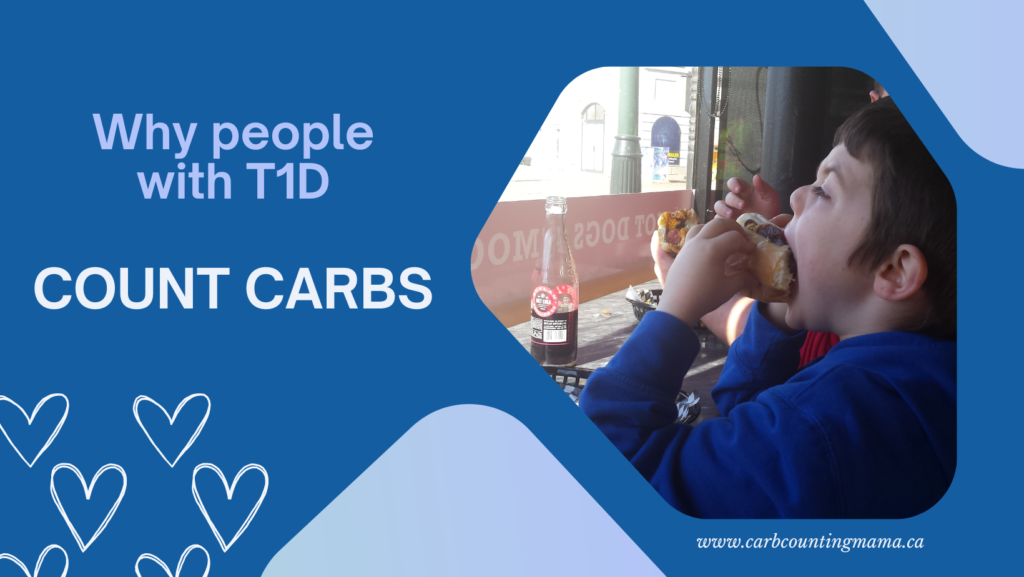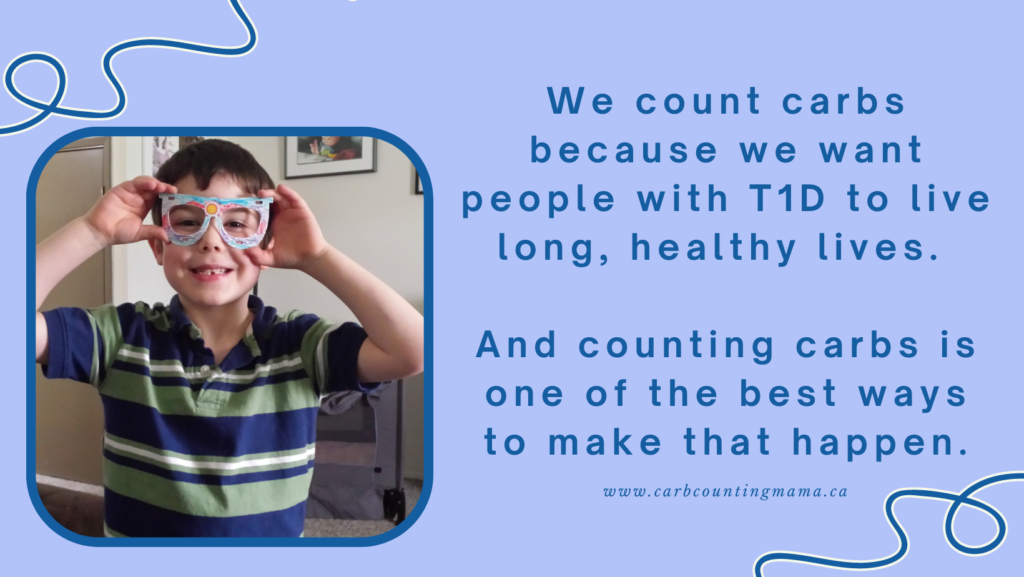My son’s first-grade class was having a party for the ten billionth time that month. I was available to help out with crafts, games, and keeping the kids somewhat contained during the festivities, so I volunteered to join the celebration. Of course, there was a table full of snacks. I quickly went to check out what was being served to see how tricky it would be to carb count. As I was looking at food labels, another mom came up to me. She asked me, “So, what do you do with the labels? Why do you need to count carbs?”

What a good question! You know I count carbs (it even says so in the title of this blog), but WHY?
It can be such a difficult question to answer.
It’s not to be on some trendy diet, to restrict the amount of sweets in our home, or to spend all my free time doing ridiculous math calculations day after day.
It is because my son has type 1 diabetes (T1D). Before I can tell you why we need to count carbs, there are a few things I need to explain about T1D.
What is T1D?
Type 1 diabetes is an autoimmune disease. It happens when the person’s immune system mistakenly attacks and kills off the insulin-producing beta cells in the pancreas.
That means the person’s body no longer produces its own insulin. People with T1D need to take insulin subcutaneously, via injections or an insulin pump, for the rest of their lives.
Why is insulin so important?
Why do we care whether or not our bodies produce insulin? Well, we need it to survive.
Insulin is the hormone that regulates blood glucose levels (the amount of sugar in your blood system). It is created by beta cells in the pancreas and your body releases it as needed to turn the food you eat into usable energy.
We need that energy to walk, talk, breathe, and even think.
Without insulin, the body tries to make energy in other ways. It starts burning fat. But when our bodies burn fat, that produces acids called ketones.
When too many ketones are produced too quickly, it can be very dangerous. Our bodies don’t have a way to efficiently get the ketones out of our system, so they just keep building up and can lead to diabetic ketoacidosis (DKA).
DKA can be a deadly complication of diabetes. And to be successful in treating DKA, you will need the thing that was missing in the first place, insulin.
We can’t live without insulin.
What does all of this have to do with counting carbs?
Since people with T1D need to take their insulin manually, and insulin is used to convert glucose into energy, we need to know how much glucose there is in order to determine how much insulin is needed.
But, where does that glucose come from?
Carbohydrates are compounds of carbon, hydrogen, and oxygen. That’s the scientific way of saying sugars, starches, and celluloses (fiber). The various sugars (sucrose or lactose for example) get broken down in the body and turned into glucose (or sometimes fructose or galactose).
That glucose needs insulin to go with it.
How do insulin and carbs work together?
We know that 90-100% of carbs break down into glucose in our bodies.
In order for our bodies to absorb the glucose from these carbs, we need insulin. For someone without T1D, their pancreas will release small amounts of insulin as needed. A little bit is secreted most of the time, with larger amounts being released when we eat.
But people with T1D don’t produce their own insulin. So they need to administer it manually. But how much do they need to take?
Because insulin and glucose work together, they have to match up.
Too much insulin will result in low blood sugar (hypoglycemia). The side effects of hypoglycemia include: confusion, shaking, inability to think straight… and if not treated promptly, seizures, loss of consciousness, and death.
Too little insulin results in high blood sugar (hyperglycemia). The side effects of hyperglycemia include: headache, blurry vision, dehydration, and vomiting. If not treated properly it can lead to DKA which can cause brain swelling, loss of consciousness, seizures, and death.
Needless to say, it’s important to figure out the right amount of insulin.
Most of our glucose, but not all, comes from carbohydrates. So, counting carbs can help to figure out how much the insulin dose should be.
Each person has their own unique insulin sensitivity. That means, one person may need a lot more or less insulin than another person, even if they’re eating the same thing.
So, we have to figure out our ICR (insulin to carb ratio). How many grams of carbs can your body process with one unit of insulin?
Sounds easy enough…
But it’s not.
To figure out what your ICR is, your doctor has to go through some trial and error when you’re diagnosed. And even when they land on an ICR that works, life happens and it needs to be adjusted frequently.
Often, people need to use different ratios for different times of day. Most people are more insulin resistant in the morning, so they need a stronger ICR for breakfast than for lunch and dinner.
And of course, insulin is a hormone. So, it’s affected by other hormones. A child going through a growth spurt? That will change their ICR. Puberty? It can change your insulin needs quickly, drastically, and frequently.
Oh, and did I mention that approximately 50% of protein also breaks down into glucose in our bodies? And 10% of fat?
These things (and much more) make it very tricky to figure out insulin doses.
While carb counting isn’t an exact science, it’s a good start. It significantly helps to avoid complications from T1D.
Why do we count carbs?
Here I am, cookie box in hand, wondering how to explain all of this to another parent without overdoing it.
She’s asking what she thinks is a simple question. Her inquisitive eyes waiting patiently for an answer.
Why do we count carbs?
I do it for my son. So that he can have treats. So that he can attend birthday parties and have cake and ice cream with his friends. I do it so he can go trick or treating, eat Christmas cookies, and go on Easter egg hunts.
But most importantly, I do it to keep him healthy. Counting carbs helps me determine how much insulin we need to give him. And without that insulin, he wouldn’t be here.

Has anyone asked you why you count carbs? How do you explain it to people? Leave a comment below!
For more tips and stories about T1D, join the Carb Counting Mama email list, and make sure to head over to the Carb Counting Mama Facebook page and “like” it.
Leave a Reply